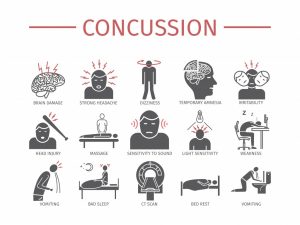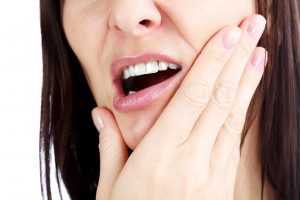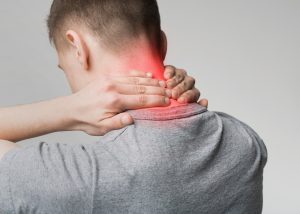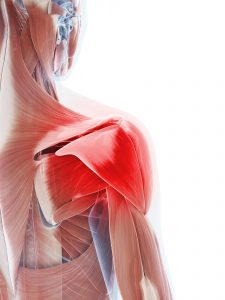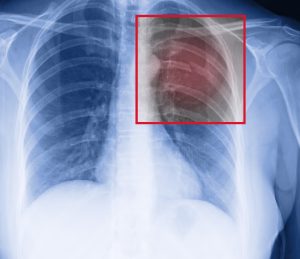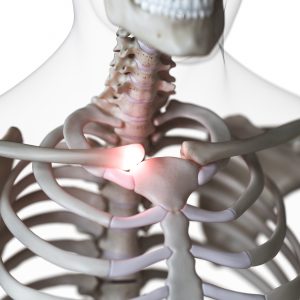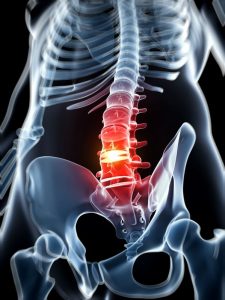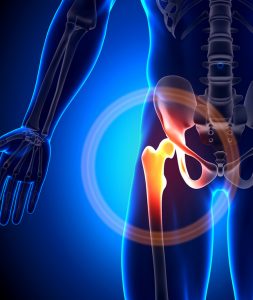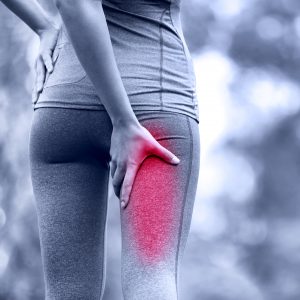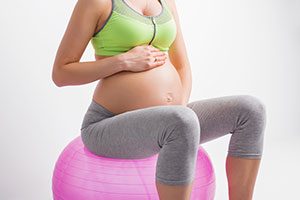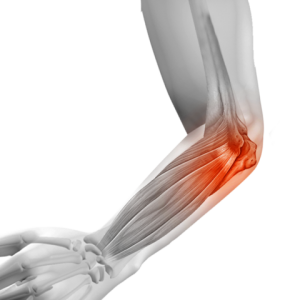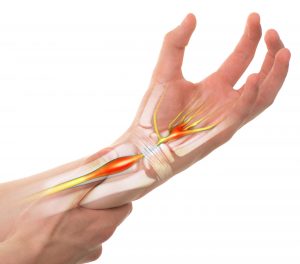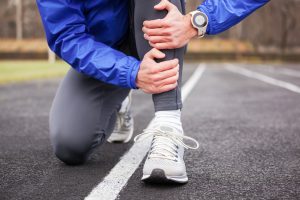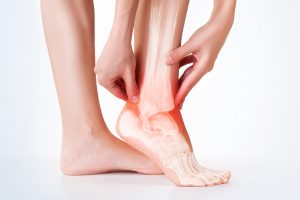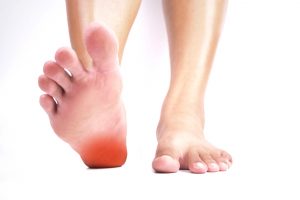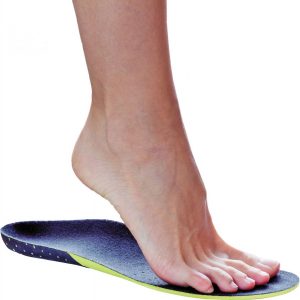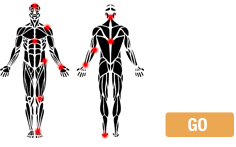HEAD
Headaches can be caused for variety of reasons.
Read More
SHOULDER
Shoulder pain can be felt on top of the shoulder, the tip of the shoulder.
Read More
ELBOW
If you are experiencing elbow pain it is most commonly related to overuse and tendinitis.
Read More
WRIST
Joint pain has increased dramatically since the invention of the smart phone.
Read More
HAND
Tingling or pain in the hand or fingers is most commonly related to nerve irritation.
Read More
STERNUM
Sharp pain in the front of the chest, or just off to the side where the ribs attached to the sternum can become irritated and inflamed with persistent coughing or trauma.
Read More
NECK
Neck pain can most frequently manifest itself as pain in the side and back of the neck radiating to the base of the neck, shoulder, arm, and hand.
Read More
BODY / THORAX
Pain in between the shoulder blades is most frequently caused by cervical disc herniation.
Read More
HIP
Hip joint pain is usually felt in the front in the groin area.
Read More
KNEE
Pain on the knee cap or the inside of the knee with stairs (usually going down) or prolonged standing and walking.
Read More
ANKLE / HEEL
Searing pain like a knife in your heel on every step, especially in the morning? You likely have plantar fasciitis.
Read More
FOOT
Commonly pain in the big toe or deformities in the big toe result from abnormal posture and walking.
Read More
JAW
Are you grinding at night? Does your jaw or head (especially your temples) hurt in the morning?
Read More
LOWER BACK
Disc herniations are one of the most common reasons for low back pain and the cause of sciatica, a generic term for pain down the leg or buttock.
Read More
BUTTOCK
Most commonly a deep ache in the middle of the buttock is a result of hip problems.
Read More
PUBIS/GROIN
Pubis pain typically is felt directly over your pubic bones and tend to be very tender when you press on them.
Read More
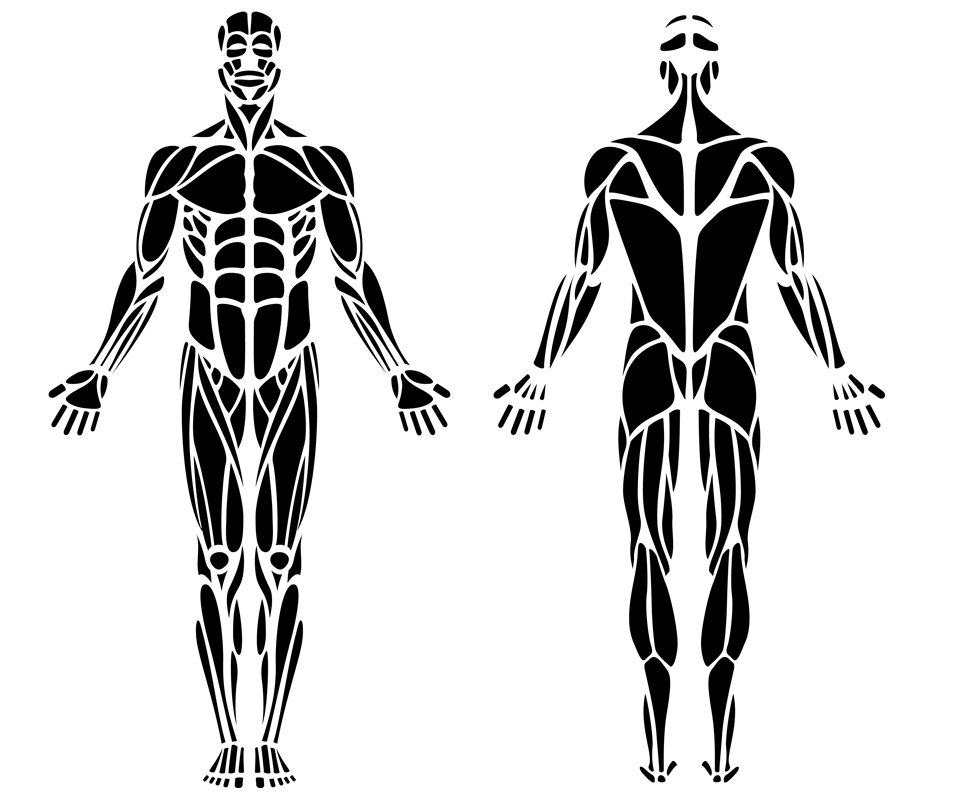
HEAD
Headaches can be felt on the temples, behind the eyes, on top of the head, or the back of the head. Headaches can be caused by a variety of reasons but generally they occur for the same reasons we get pain everywhere else in our bodies: there is injury or perceived injury. Because your therapist at PhysioActive can maximize the optimization of blood supply, waste removal, and muscle balance, we can alleviate headaches. Headaches can be reduced with physiotherapy, osteopathy, acupuncture and massage therapy, or most commonly the combination of these with acupuncture in conjunction with a specifically designed program.
Dizziness and vertigo, which is the feeling of the world moving or being unsteady yourself, can be an indication that these balance systems are not working optimally. Vestibular and functional neurological treatment can assist in rehabilitating your nervous system and remove the symptoms. Your highly trained therapist will prescribe specific eye and balance exercises. Manual therapy may be directed to the eyes, ears, jaw and tongue to balance the neurological system and alleviate symptoms most practitioners believed were impossible to treat.
Concussion treatment at Physioactive is cutting edge with access to osteopathy, physiotherapy and acupuncture. A variety of treatment tools including cranial treatment and neurological re-training exercises can most effectively and efficiently return the brain to optimal function.
PhysiotherapyAcupunctureOsteopathy
JAW
Are you grinding at night? Does your jaw or head (especially your temples) hurt in the morning? Do your headaches relate to eating or stress? When you open and close your mouth, do you hear clicking or does your jaw shift from side to side? Does your dentist tell you that you are wearing down your teeth? These are signs that you may have an issue with your jaw joint or TMJ/TMD.
Long term implications can result from a poorly functioning jaw. Any type of whiplash will impact your jaw. Are you aware that your tongue should sit at the top of your mouth and that your teeth come together each time you swallow? These intricate movements must be coordinated to prevent jaw, neck and head pain. Your professionals at PhysioActive can help. Our therapists will collaborate to ensure a comprehensive physiotherapy program.
- Teeth ache
- Jaw pain
- Clicking or grinding
- Malocclusion (biting difficulties)
- Face pain
- Braces resulting in pain or headaches
NECK
Neck pain can most frequently manifest itself as pain in the side and back of the neck radiating to the base of the neck, shoulder, arm, and hand. Irritation of the nerves in the neck can also produce pins and needles and numbness into the hand. Acute trauma like a car accident or sporting injury can cause disc herniation or nerve compression. Chronic neck pain is increasing in frequency with our more sedentary and stressful lifestyles. Poor posture, and our increased use of smart phones and computers, have increased the amount of neck patients we see. Even children with their smart phones and heavy backpacks are experiencing neck pain at a young age.
Simple corrected breathing, stretches and strengthening exercises can be employed to quickly alleviate neck pain. Improved posture not only helps with pain, but will bring you stress relief, clearer thoughts and better functionality. Ergonomic changes or sporting changes may be necessary to prevent re-injury. Our therapists at PhysioActive are confident working with your employer or coaches as well.
A flexible and strong neck is essential for sporting performance. Our elite athletes have been able to increase the throwing speed and performance times by optimizing spinal strength and control.
- Whiplash
- Disc herniation
- Facet syndrome
- Spinal instability/spondylolisthesis
- Spinal stenosis
- Wry neck / torticollis
SHOULDER
Pain coming from the shoulder is usually felt in the front or back of the shoulder and can radiate down the arm. The rotator cuff is the most common culprit for your shoulder and arm pain. This condition is not just for baseball pitchers. If you have pain while reaching or lifting objects this could be the cause. Pain on the top or tip of the shoulder is usually from the AC joint, commonly injured by falling on the arm or in contact sports.
Rotator cuff pain is typically felt during activities such as reaching overhead or behind you, like reaching to the back seat or putting on your bra. Reaching overhead and lifting can be particularly painful and will be worsened with throwing activities.
Initially, rest is imperative to reducing pain. Modalities such as ice and heat, laser and magnetic bio stimulation are useful in the acute phase. More chronic conditions might benefit from shockwave therapy.
Resting alone will not restore the strength and control needed for normal function. Regardless which route you take, physiotherapy assessment and movement patterning evaluation is essential to restore proper muscle function.
- Rotator cuff tear/tendinitis/impingement
- Frozen shoulder
- AC joint separation
- Shoulder dislocation
- Shoulder osteoarthritis
- Labral tear
- Shoulder Bursitis
- Nerve palsy
- Instability
- Shoulder replacement
BODY/THORAX
Pain in between the shoulder blades is most frequently caused by cervical disc herniation. If your pain changes with neck movements, this could be the cause. Other common possibilities are thoracic disc and rib problems.
MID BACK
Sharp pain in the mid back can often be caused from a twisting injury. If the pain worsens with a deep breath or cough, this could be your rib. A manipulation in the first 24 hours usually prevents this pain from getting worse. If the pain in your mid back or chest is a result of trauma, you may have sustained a rib fracture. It is normal to have pain with a deep inhalation, but if you are severely short of breath you need to go to the hospital.
Chronic, deep achy body pain frequently relates to “visceral pain” which means pain coming from your organs. If the pain is severe, unrelenting or getting worse please consult your physician. If the pain is affected by movement or change of position, PhysioActive can help. Our physiotherapists and osteopaths are trained to restore normal motion not just to your ribs and spine, but also to the tissues underneath them. Don’t be surprised if you feel lighter and can breathe easier after your appointment.
STERNUM
Sharp pain in the front of the chest, or just off to the side where the ribs attach to the sternum can become irritated and inflamed with persistent coughing or trauma. Your physiotherapist at PhysioActive will evaluate whether your ribs are moving too much or too little. This greatly affects the treatment approach. Your therapist will be able to determine if your symptoms are related to the joints and muscles versus heart pain or angina.
Pain from irritation of the rib joints can be very painful. If the pain is chronic as a result of unstable rib joints, PhysioActive’s affiliation with the Canadian Centre for Integrative Medicine will address any need for injections if necessary.
Our cardiac rehab program has been effective at returning our patients who have had heart attacks or heart surgery to return to normal productive lives.
LOWER BACK
Disc herniations are one of the most common reasons for low back pain and the cause of sciatica, a generic term for pain down the leg or buttock. Research has shown that a combination of hands on therapy with modalities for pain relief, such as acupuncture, magnetic biostimulation in conjunction, and a properly designed exercise program is the most effective way of eliminating the pain and keeping it away.
Other popular terms used to describe a back that is aging and causing pain as a result of compression include stenosis, spondylitis, degenerative disc disease (DDD), osteoarthritis. These conditions do not mean you have to suffer in pain. Degeneration is a part of life, but pain doesn’t have to be.
OsteopathyPhysiotherapyExercise PrescriptionAcupunctureMagnetic Biostimulation
- Disc herniation
- Facet syndrome
- Spinal instability/spondylolisthesis
- Spinal stenosis
- Sacroiliac joint dysfunction
- Sacroiliac instability – all professions as well as injection
- Pregnancy discomfort
HIP
Hip joint pain and arthritis is usually felt in the front in the groin area. It can radiate down the front of the leg to the inside of the knee. Hip pain can also be felt in the buttock. Prolonged standing or excessive bending of the hip (such as squatting or sitting in a low or soft chair) can reproduce this pain. Your hip flexors (hip pointer) can also cause pain in the front of the hip, although this pain is usually farther out to the side and hurts when trying to actively lift your knee to the chest. At Physioactive, we have become very effective in treating anterior hip impingement both in preventing surgery, but also post-operatively.
Pain on the outside of the leg or hip is not usually from the joint itself but from wearing down of the ITB or bursae on the outside of the thigh bone (the femur). Our therapists may recommend orthotics in combination with a detailed exam of the pelvis, low back and leg.
- Hip arthritis
- Anterior Hip Impingement (Femoroacetabular Impingement)
- Hip flexion stain (hip pointer)
- Pirformis syndrome
- Hip bursitis and ITB syndrome (at the hip)
- Snapping hip syndrome
- Myalgia parasthetica
BUTTOCK
Most commonly, a deep ache in the middle of the buttock is a result of hip problems. A sharp pain radiating up or down from the buttock is more typically a result of nerve pain either entrapped at the low back, or the sciatic nerve around the piriformis.
If the pain comes when you are walking or standing for a long period, this is more frequently related to hip or sacroiliac pain. If your pain is more prominent in sitting, you may be compressing the sciatic nerve under the piriforms or irritation from a disc herniation.
Because pain in the buttock comes from many possible causes, comprehensive evaluation of your low back, pelvis, leg, and foot is required to effectively permanently relieve your symptoms.
Other conditions commonly seen producing pain in the butt include hamstring injuries which are typically seen in runners.
PhysiotherapyIntra-Muscular StimulationExercise Prescription
PUBIS or GROIN PAIN and PELVIC HEALTH
Pelvic pain can be typically felt directly over your pubic bones and tend to be very tender when you press on them. This condition frequently occurs during pregnancy or during delivery. The pelvic floor, hips, and pelvis must be treated to de-stress the pubic region. Your therapist at PhysioActive will always explain what they are doing and walk you through the evaluation and treatment.
- Pelvic Floor Weakness and Incontinence
- Pregnancy discomfort
- Osteitis Pubis
- Groin Strain
- Adductor Strain
- Pubic (Symphysis Pubis) Instability
- Pelvis Congestion Syndrome (Massage and Osteopathy)
- Scar Tissue (Physio, Massage)
- Visceral Issues Such As Bowel, Menstrual (Osteopath, Acupuncture)
ELBOW
If you are experiencing elbow pain it is most commonly related to overuse and tendonitis. You might experience pain on the tip of the elbow with pain on clipping and fine finger movements such as playing the piano or using a mouse or keyboard.
This requires a thorough assessment of the elbow itself, ergonomics (how you were doing things at work), as well as contributing factors that may be contributing to your symptoms such as posture, neck or upper back problems and nerve or blood vessel entrapment.
Successful treatment typically begins with physiotherapy where we use acupuncture, laser, hands-on therapy as well as a unique exercise program to get quick results. We frequently use acupuncture to assist in pain reduction.
A resistant tennis elbow is successfully treated with Shockwave Therapy.
PhysiotherapyMassage TherapyAcupunctureLaserShockwave Therapy
WRIST
Historically, most of our wrist patients were seen after a fall onto their outstretched hand resulting in a Colles fracture or wrist strain. Thanks to smartphones, poor posture and computers, pain on the side of the wrist has increased dramatically. Wrist pain can also develop during pregnancy or on the arrival of a newborn. The changes in hormones, and the awkward position of your wrist carrying and breast-feeding your newborn frequently irritates the wrist joint.
Sharp or aching pain on the thumb side of wrist is popular with our pregnant patients, but our smartphone users and chefs frequently suffer from irritation of the thumb tendons as they cross the wrist joint as well. The swelling in the tendons and their sheaths need rest and anti-inflammatory modalities. A comprehensive evaluation of the how the hand and arm function as well as the nerves to the wrist and hand must be carried out. For chronic conditions or pain on both sides, IMS and a thorough evaluation of the neck and upper back will be required.
- Colles fracture
- TFCC
- Carpal tunnel syndrome
- Dequervain’s
- CMC thumb arthritis
- Skier’s thumb
- Trigger finger
- Dupuytren’s contracture
- Nerve palsy
- Mallet finger
- Raynaud’s phenomenon
HAND
Tingling or pain in the hand or fingers is most commonly related to nerve irritation. The most common condition we see is carpal tunnel syndrome. Knowing which fingers begin to tingle or go numb is essential information for your therapist to determine where the impingement of your nerve is occurring. Most nerve entrapments are successfully treated with physiotherapy. Acupuncture can be effectively used to calm the nerves and alleviate your pain.
Before undergoing surgery, make sure your nerve is only entrapped at the wrist. At PhysioActive we successfully treat most of our carpal tunnel patients with no need for surgery. A nerve is like a hose and just because the water isn’t coming out at the end (fingers), it doesn’t mean that there aren’t problems elsewhere. Consult with your PhysioActive physiotherapists to understand your symptoms and test results, if any. Most nerve entrapment’s are successfully treated with physiotherapy.
- CMC thumb arthritis
- Skier’s thumb
- Trigger finger
- Dupuytren’s contracture
- Nerve palsy
- Mallet finger
- Raynaud’s phenomenon
p
KNEE
Acute knee injuries can lead to pain and swelling. If the swelling is large and rapid (10 minutes) you likely have a serious ligament tear or fracture and should seek medical help. If the swelling occurs over 24 hours and the pain is on the joint line you may have torn your meniscus. This usually occurs as a result of a twisting injury.
The most common chronic knee pain is felt on the inside of the knee. If it is on the joint line, it is most likely arthritis or a degenerative meniscal injury and there may not be any visible swelling with these. Pain is usually felt at full knee bending or straightening. If the pain is below the joint line of the tibia it is most likely bursitis at the pes anserine, a common attachment site for several key muscles.
Pain on the front of the knee near the surface is usually coming from the knee cap. This is called Patellofemoral syndrome and the pain is usually aggravated by walking downstairs, or squatting and jumping. If the pain is below the knee cap this could be jumper’s knee or patellar tendonitis.
In children, this excessive pull from the quadriceps can cause excessive pulling on the patellar tendon leading to bone growth where the tendon attaches. There can be swelling and pain on this insertion. This paediatric condition is called Osgood Schlatter’s disease.
Our therapists will accurately assess the cause of your pain. Your evaluation and treatment will usually include the feet and pelvis in order to reduce the stress on the knees. Local treatment to heal the injured tissue and loss of range of motion is essential. Ice, compression and elevation, as well as gentle biking can help with inflammation until you get a chance to see your therapist.
- Knock knees
- ACL tear
- Meniscal tear
- Patellofemoral pain syndrome (knee cap pain)
- Osgood-Schlatter’s disease
- Patellar tendinitis
- ITB syndrome (on the outside of the knee)
- Shin splints
- Calf strain or cramping
ANKLE
Inversion sprains or “rolling your ankle” can occur during cutting sports such as soccer, basketball or volleyball. It usually results in pain and swelling on the outside of the ankle. If there is pain on the inside of the ankle as well as the outside, this is indicative of a more severe injury. These types of sprains can also occur walking on uneven ground or missing a step. If you have “weak” ankles or find yourself tripping more often or rolling your ankle when walking normally, you most likely have not properly rehabilitated your proprioceptive or balance system.
Along with specific range of motion exercises and specific joint mobilizations (there are 33 joints in the foot), your therapist will use hands-on therapy to assess all these joints to make sure each is moving properly.
Pain on the front of the ankle can also be tarsal tunnel pain, especially if it is very tender to touch and radiating into the top of the foot and toes.
- Tarsal Tunnel
- Ankle Sprain
- Achilles Tendinitis
- Tendonitis
- Extensor Retinaculum tear
- Shin Splints
- Ankle Instability “Weak Ankles”
p
HEEL
Have you experienced searing pain like a knife on the bottom of your heel on every step, especially in the morning? You likely have plantar fasciitis. If the pain is more pronounced in the back of the heel, especially when pushing off during walking, you probably have Achilles tendinitis. PhysioActive has the complete foot care program including an ankle compression stocking, orthotics, shockwave and skilled manual therapists.
Plantar fasciitis produces sharp pain under the heel usually worst in the morning or first few steps after sitting. This may or may not be associated with a heel spur. Treatment may include, orthotics, modalities to decrease inflammation and promote healing. Assessment of the whole leg, back and balance are also essential to prevent return of your pain. For the most persistent chronic conditions shockwave has a 90% effectiveness.
Pain at the back of the heel may be associated with swelling or thickening of the Achilles tendon. It is important to assess for tightness in the calf. IMS may be necessary for more permanent resolution of the tightness. When stretching isn’t working, it is usually because the nerves to the leg are causing the tightness and a neurological approach will be necessary. Your physiotherapist will guide you through this process.
FOOT
Commonly pain in the big toe or deformities in the big toe result from abnormal posture and walking. This leads to premature wearing of the toe joint causing pain and deformation. Over time this can lead to a bunion. If foot mechanics and walking patterns are addressed early enough, this common deformity and its associated pain can be prevented!
The second most common condition in the foot is pain in the ball of the foot leading to searing pain and pins and needles into the toes. This is a condition called metatarsalgia or Morton’s neuroma. Abnormal foot mechanics lead to irritation of the toe nerves as it enters the toes.
If you also have cold feet, excessive sweating or poor circulation, a treatment course of IMS, shockwave and osteopathy may be the extra care needed to get you better. In more acute cases physiotherapy and modalities are very successful in curing this condition. Sometimes orthotics may be necessary to offload the injured area.
Intra-Muscular StimulationShockwave TherapyOsteopathyPhysiotherapy
- Flat feet
- Bunion
- Sesmoiditis
- Metatarsalgia
- Arch pain
- Heel spur
- Morton’s neuoma
- Turf toe
- Hallux Valgus (Bunion)
- Hallux Rigidis (stiff OA of the toe)
Injuries/conditions not specific to one pain area
Chronic pain
Incontinence
Fibromyalgia
Neuropathic pain
Balance disorders
Celiac disease
Osteomyelitis
Osteoarthritis
Dislocation
Pregnancy discomfort, labour preparation and post-natal care
Conditions only treated by Osteopathy and Traditional Chinese Medicine or Traditional Acupuncture
- Abdominal/visceral complaints
- Fertility issues
- Irritable bowel syndrome
- Difficult digestion, acid reflux, constipation
- Painful periods and ovulation/bladder with or without pelvic pain
- Peadiatric conditions such as colic, development delay, flat spots on the head
- labour preparation and post-natal care
- Children: unsettled babies, colic, recurrent ear infections
Paediatrics
- Posture problems
- Scoliosis
- Torticollis
- Flat feet
- Toe walking

